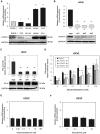FOXA1 promotes tumor progression in prostate cancer via the insulin-like growth factor binding protein 3 pathway
- PMID: 22879989
- PMCID: PMC3411739
- DOI: 10.1371/journal.pone.0042456
FOXA1 promotes tumor progression in prostate cancer via the insulin-like growth factor binding protein 3 pathway
Abstract
Fork-head box protein A1 (FOXA1) is a "pioneer factor" that is known to bind to the androgen receptor (AR) and regulate the transcription of AR-specific genes. However, the precise role of FOXA1 in prostate cancer (PC) remains unknown. In this study, we report that FOXA1 plays a critical role in PC cell proliferation. The expression of FOXA1 was higher in PC than in normal prostate tissues (P = 0.0002), and, using immunohistochemical analysis, we found that FOXA1 was localized in the nucleus. FOXA1 expression levels were significantly correlated with both PSA and Gleason scores (P = 0.016 and P = 0.031, respectively). Moreover, FOXA1 up-regulation was a significant factor in PSA failure (P = 0.011). Depletion of FOXA1 in a prostate cancer cell line (LNCaP) using small interfering RNA (siRNA) significantly inhibited AR activity, led to cell-growth suppression, and induced G0/G1 arrest. The anti-proliferative effect of FOXA1 siRNA was mediated through insulin-like growth factor binding protein 3 (IGFBP-3). An increase in IGFBP-3, mediated by depletion of FOXA1, inhibited phosphorylation of MAPK and Akt, and increased expression of the cell cycle regulators p21 and p27. We also found that the anti-proliferative effect of FOXA1 depletion was significantly reversed by simultaneous siRNA depletion of IGFBP-3. These findings provide direct physiological and molecular evidence for a role of FOXA1 in controlling cell proliferation through the regulation of IGFBP-3 expression in PC.
Conflict of interest statement
Figures





Similar articles
-
FOXA1 promotes tumor progression in prostate cancer and represents a novel hallmark of castration-resistant prostate cancer.Am J Pathol. 2012 Feb;180(2):848-61. doi: 10.1016/j.ajpath.2011.10.021. Epub 2011 Dec 2. Am J Pathol. 2012. PMID: 22138582
-
Androgen receptor-independent function of FoxA1 in prostate cancer metastasis.Cancer Res. 2013 Jun 15;73(12):3725-36. doi: 10.1158/0008-5472.CAN-12-3468. Epub 2013 Mar 28. Cancer Res. 2013. PMID: 23539448 Free PMC article.
-
FOXA1 modulates EAF2 regulation of AR transcriptional activity, cell proliferation, and migration in prostate cancer cells.Prostate. 2015 Jun 15;75(9):976-87. doi: 10.1002/pros.22982. Epub 2015 Mar 23. Prostate. 2015. PMID: 25808853 Free PMC article.
-
Pioneer of prostate cancer: past, present and the future of FOXA1.Protein Cell. 2021 Jan;12(1):29-38. doi: 10.1007/s13238-020-00786-8. Epub 2020 Sep 18. Protein Cell. 2021. PMID: 32946061 Free PMC article. Review.
-
FOXA1: a transcription factor with parallel functions in development and cancer.Biosci Rep. 2012 Apr 1;32(2):113-30. doi: 10.1042/BSR20110046. Biosci Rep. 2012. PMID: 22115363 Free PMC article. Review.
Cited by
-
Structurally Oriented Classification of FOXA1 Alterations Identifies Prostate Cancers with Opposing Clinical Outcomes and Distinct Molecular and Immunologic Subtypes.Clin Cancer Res. 2025 Mar 3;31(5):936-948. doi: 10.1158/1078-0432.CCR-24-3471. Clin Cancer Res. 2025. PMID: 39745364 Free PMC article.
-
Growth Hormone/Insulin Growth Factor Axis in Sex Steroid Associated Disorders and Related Cancers.Front Cell Dev Biol. 2021 Mar 18;9:630503. doi: 10.3389/fcell.2021.630503. eCollection 2021. Front Cell Dev Biol. 2021. PMID: 33816477 Free PMC article. Review.
-
Sexual dimorphism in the expression of GKN2 and FOXA2 genes in the human stomach.Mol Biol Rep. 2019 Apr;46(2):2355-2362. doi: 10.1007/s11033-019-04692-z. Epub 2019 Feb 18. Mol Biol Rep. 2019. PMID: 30778924
-
Expression of L-type amino acid transporter 1 as a molecular target for prognostic and therapeutic indicators in bladder carcinoma.Sci Rep. 2020 Jan 28;10(1):1292. doi: 10.1038/s41598-020-58136-x. Sci Rep. 2020. PMID: 31992742 Free PMC article.
-
Role of steroid receptor and coregulator mutations in hormone-dependent cancers.J Clin Invest. 2017 Apr 3;127(4):1126-1135. doi: 10.1172/JCI88885. Epub 2017 Apr 3. J Clin Invest. 2017. PMID: 28368289 Free PMC article. Review.
References
-
- Li R, Wheeler T, Dai H, Frolov A, Thompson T, et al. (2004) High level of androgen receptor is associated with aggressive clinicopathologic features and decreased biochemical recurrence-free survival in prostate: cancer patients treated with radical prostatectomy. Am J Surg Pathol 28: 928–934. - PubMed
-
- Endo T, Uzawa K, Suzuki H, Tanzawa H, Ichikawa T (2009) Characteristic gene expression profiles of benign prostatic hypertrophy and prostate cancer. Int J Oncol 35: 499–509. - PubMed
Publication types
MeSH terms
Substances
LinkOut - more resources
Full Text Sources
Other Literature Sources
Medical
Research Materials
Miscellaneous

